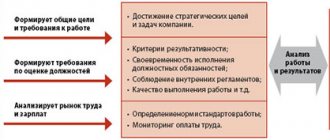Forms and principles of social partnership in an organization
The following forms of joint venture are distinguished:
- Collective meetings to work on drawing up various agreements.
- Consultations regarding the management of labor relations.
- Participation of workers and their representatives in the management of the company.
- Participation of company representatives and owners in pre-trial conflict resolution.
Among the legal forms of joint ventures, collective agreements are distinguished.
Basic principles of the joint venture:
- Each participant has the right to start negotiations.
- The interests of each side of the labor space must be respected.
- The law gives participants in labor relations a lot of space to resolve issues (for example, the activities of a company can be regulated by local acts).
- The agreements drawn up must not conflict with the law.
- To appoint representatives, you need to organize a meeting of workers and draw up a protocol (if it is a trade union) or an order (if it is representatives of the employer).
- Representatives are given the right to defend the interests of their group.
- The range of issues that will be on the agenda is determined by the participants.
- The basis of the joint venture is freedom of choice. All decisions of participants must be completely voluntary.
- The clauses specified in collective agreements must be fulfilled. Supervisory structures are responsible for monitoring implementation.
If the adopted provisions were not implemented, administrative liability is imposed on the guilty person.
About the authors CHAPTER 1. The concept of labor law, the subject and method of labor law 1.1. Concept and subject of labor law 1.2. Labor law method 1.3. Labor law system 1.4. Functions of labor law 1.5. The relationship between labor law and related branches of law 1.6. Basic principles of labor law CHAPTER 2. SOURCES OF LABOR LAW AND THEIR CLASSIFICATION 2.1. The concept of sources of labor law 2.2. Division of powers in the field of labor and related relations 2.3. Effect of laws and other normative legal acts containing labor law norms over time 2.4. Effect of regulations in space 2.5. Effect of regulations on labor by categories of workers 2.6. Local labor regulation CHAPTER 3. Subjects of labor law 3.1. The concept of a subject of labor law 3.2. The employee as a subject of labor law 3.3. Rights and obligations of the employee as a subject of labor law 3.4. Employer as a subject of labor law 3.5. Rights and obligations of the employer as a subject of labor law 3.6. Administration of the organization as a subject of labor law 3.7. The labor collective as a subject of labor law 3.8. Trade union as a subject of labor law CHAPTER 4. Labor relations 4.1. Concept and system of legal relations 4.2. Features of labor relations 4.3. Grounds for the emergence of labor relations 4.4. Labor relations arising as a result of election to a position or competition 4.5. Legal relations for ensuring employment and employment 4.6. Social partnership legal relations in the sphere of labor 4.7. Legal relations regarding professional training in production 4.8. Legal relationship for supervision and control of labor protection and compliance with labor legislation 4.9. Legal relationship regarding the financial liability of the parties to the employment contract for damage caused to the other party 4.10. Legal relations for resolving labor disputes Chapter 5. Social partnership in the sphere of labor 5.1. Concept and principles of social partnership 5.2. System of social partnership and its forms 5.3. Representatives of workers in social partnership 5.4. Employer representatives in social partnership 5.5. Social partnership bodies 5.6. Procedure for conducting collective bargaining 5.7. Resolution of disagreements 5.8. Guarantees and compensation for persons participating in collective bargaining 5.9. Concept and content of a collective agreement 5.10. The procedure for developing a collective agreement and its validity period 5.11. Concept and types of agreements 5.12. The procedure for developing a draft agreement and its conclusion 5.13. Validity of the agreement 5.14. Registration of a collective agreement, agreements and control over their implementation 5.15. Participation of employees in the management of the organization 5.16. Responsibility of the parties to the social partnership CHAPTER 6. Legal regulation of employment and employment of the POPULATION 6.1. The concept of employment and employment 6.2. Legal status of the unemployed 6.3. Rights and obligations of the unemployed 6.4. Unemployment benefit 6.5. Conditions and terms of payment of unemployment benefits 6.6. The right of citizens to promote employment and employment 6.7. Participation of employers in ensuring employment of the population 6.8. Organization of public works 6.9. Legal organization of employment of citizens 6.10. Social guarantees in case of job loss and unemployment 6.11. Peculiarities of employment of certain categories of citizens CHAPTER 7. Employment contract 7.1. The concept and meaning of an employment contract. Parties to the employment contract 7.2. Contents of the employment contract 7.3. Form of employment contract 7.4. Duration of the employment contract 7.5. Work book CHAPTER 8. Procedure for concluding an employment contract 8.1. The procedure for concluding an employment contract and documents presented when concluding an employment contract 8.2. Age at which it is permissible to conclude an employment contract 8.3. Guarantees and restrictions when concluding an employment contract 8.4. Form of employment contract. Registration of employee reception 8.5. Test when hiring an employee CHAPTER 9. Changes in the employment contract 9.1. The procedure for changing the terms of the employment contract 9.2. The concept of transfer and relocation of an employee to another job 9.3. Changes in the essential terms of the employment contract 9.4. Temporary transfer of an employee to another job in case of production necessity 9.5. Labor relations when changing the owner of an organization's property, changing its jurisdiction and reorganization 9.6. Removal of an employee from work CHAPTER 10. Procedure for terminating an employment contract 10.1. General grounds for termination of an employment contract 10.2. Termination of an employment contract at the initiative of the employee (at his own request) 10.3. Termination of an employment contract at the initiative of the employer 10.4. Termination of an employment contract due to circumstances beyond the control of the parties 10.5. Termination of an employment contract due to violation of established hiring rules 10.6. Procedure for registering termination of an employment contract 10.7. Mandatory participation of the elected trade union body in the consideration of issues related to the termination of an employment contract at the initiative of the employer CHAPTER 11. Protection of personal data of the employee 11.1. Concept of personal data 11.2. The procedure for storing and using employee data CHAPTER 12. Working hours 12.1. Concept and types of working time 12.2. Reduced working hours and daily work 12.3. Overtime and part-time work 12.4. Regime and recording of working hours, irregular working hours and shift work CHAPTER 13. Rest time 13.1. Concept and types of rest time 13.2. Non-working holidays 13.3. Concept and types of vacations 13.4. Calculation of length of service giving the right to annual basic paid leave 13.5. The procedure for granting annual paid vacations, their extension, transfer, recall from vacation 13.6. Replacement of unused vacation with monetary compensation CHAPTER 14. Legal regulation of wages 14.1. The concept of remuneration. Basic state guarantees for remuneration of workers 14.2. Wage. Minimum wage 14.3. Forms of remuneration and wage setting 14.4. Procedure, place and terms of payment of wages 14.5. Wage systems 14.6. Limitation of deductions from wages 14.7. Calculation of average wages 14.8. Payment terms upon dismissal 14.9. Responsibility of the employer for violation of deadlines for payment of wages and other amounts due to the employee 14.10. Tariff systems of remuneration and incentive payments 14.11. Remuneration for deviations from normal conditions 14.12. Labor rationing CHAPTER 15. Guarantees and compensation 15.1. The concept of guarantees and compensation 15.2. Guarantees and compensation when performing state and public duties 15.3. Guarantees and compensation to the employee in connection with loss of ability to work 15.4. General characteristics of other guarantees and compensation CHAPTER 16. Labor regulations. Labor discipline 16.1. Keepers and structure of internal labor regulations 16.2. Incentives for success in work and the procedure for their application 16.3. Disciplinary liability of the employee 16.4. Types of disciplinary sanctions 16.5. The procedure for applying disciplinary sanctions CHAPTER 17. Professional training, retraining and advanced training of employees 17.1. The right of workers to professional training and advanced training at work 17.2. Rights and obligations of the employer in the field of professional training, retraining and advanced training of employees 17.3. Concept and content of the student agreement CHAPTER 18. Labor protection 18.1. The concept and meaning of labor protection 18.2. Regulations on labor protection 18.3. Safety regulations 18.4. Responsibilities of the employer to ensure labor safety 18.5. Responsibilities of the employee to ensure labor protection 18.6. Labor protection service in the organization 18.7. Guarantees of the employee's right to labor protection CHAPTER 19. Investigation and recording of industrial accidents 19.1. Accidents subject to investigation and recording at the enterprise 19.2. Procedure for investigating accidents 19.3. Time frame for accident investigation 19.4. The procedure for preparing accident investigation materials 19.5. The procedure for registration and accounting of industrial accidents CHAPTER 20. Features of labor protection of certain categories of workers 20.1. Labor protection for women and persons with family responsibilities 20.2. Labor protection for young people and people with reduced ability to work CHAPTER 21. Financial liability of the parties to the employment contract 21.1. Concept and conditions for the occurrence of financial liability 21.2. Financial liability of the employer to the employee 21.3. Financial liability of the employee to the employer 21.4. Determination of the amount of damage caused and the procedure for its recovery 21.5. Types and limits of employee liability CHAPTER 22. Features of legal regulation of labor of certain categories of workers 22.1. Peculiarities of regulation of women's labor 22.2. Peculiarities of legal regulation of labor of workers with children 22.3. Peculiarities of labor regulation for workers under eighteen years of age 22.4. Peculiarities of labor regulation of the head of the organization and members of collegial executive bodies 22.5. Peculiarities of legal regulation of labor of part-time workers 22.6. Peculiarities of labor regulation for temporary (for a period of up to two months) and seasonal workers 22.7. Peculiarities of legal regulation of labor of workers working on a rotational basis 22.8. Peculiarities of labor regulation of workers working for employers - individuals, as well as homeworkers 22.9. Peculiarities of labor regulation for workers working in the Far North and equivalent areas 22.10. Peculiarities of labor regulation for transport workers 22.11. Peculiarities of labor regulation for teaching staff 22.12. Peculiarities of labor regulation for employees of diplomatic and other foreign institutions of the Russian Federation 22.13. Peculiarities of labor regulation for employees of religious organizations 22.14. Peculiarities of labor regulation for athletes and coaches CHAPTER 23. Protection of labor rights and freedoms 23.1. Ways to protect labor rights and freedoms 23.2. State supervision and control over compliance with labor legislation as a way to protect labor rights 23.3. Federal Labor Inspectorate, principles of its activities and tasks 23.4. Main powers of the Federal Labor Inspectorate 23.5. Basic rights of state labor inspectors 23.6. Responsibilities of state labor inspectors 23.7. Interaction of the Federal Labor Inspectorate with state bodies, local governments and other organizations 23.8. Specialized state supervisions 23.9. Protection of labor rights of workers by trade unions 23.10. Responsibilities of the employer to create conditions for the activities of the elected body of the primary trade union organization CHAPTER 24. Consideration and resolution of individual labor disputes 24.1. Concept and classification of individual labor disputes 24.2. Principles for considering individual labor disputes. 24.3. Procedure for consideration of individual labor disputes 24.4. Consideration of individual labor disputes in courts 24.5. The procedure for executing decisions of the commission on labor disputes CHAPTER 25. Consideration and resolution of collective labor disputes 25.1. The concept and stages of resolving a collective labor dispute 25.2. Procedure for declaring a strike 25.3. Illegal strikes 25.4. Guarantees and legal status of workers in connection with a strike and resolution of a collective labor dispute 25.5. Responsibility of the parties to the employment contract for violation of the legislation on collective labor disputes CHAPTER 26. Legal responsibility for violation of labor legislation 26.1. The concept of legal liability 26.2. Types of legal liability CHAPTER 27. International legal regulation of labor 27.1. The concept of international legal regulation of labor and its subjects 27.2. Sources of international labor law 27.3. International legal regulation of employment, wages and labor protection Glossary of terms used when solving test tasks
Parties of social partnership
There are two sides to the joint venture - the workers and the employer. These groups must be represented by certain people chosen by the participants. They will be considered representatives of:
- Workers . As a rule, these are trade unions. If company employees do not participate in trade unions, they can choose their representative by secret ballot.
- Employer . This is the head of the company himself or his representatives with appropriate powers. Also, the manager may be a member of a non-profit association of entrepreneurs. This is a union whose goal is to defend its interests before trade unions and government agencies.
The main rule of a joint venture is that you need to choose one person who will represent the interests of the entire group.
Benefits of social partnership (what is social partnership)
The main advantage of social partnership is the creation of an atmosphere in which the employee feels responsible for the effectiveness of the company. The employer no longer appears hostile and alien to the employee, since the worker himself personally takes part in the development of the enterprise. As a result, staff become more proactive, loyal and efficient.
This is the benefit of organizing social partnerships for employers.
In terms of benefits relevant to workers, social partnership helps them to defend their legitimate interests through legal means.
Employees can expect that their complaints will be investigated and that appropriate measures will be taken to improve the company environment.
Organization of social partnership in the company
The basis of social partnership is an agreement between participants in labor relations. The Civil Code of the Russian Federation does not specify special requirements for this agreement. It is usually compiled according to the following scheme:
- Name.
- Date of creation.
- Introduction: names of participants, representatives.
- Subject of the agreement.
- Rights and obligations of the trade union.
- Rights and obligations of the employer.
- Procedure for fulfilling obligations.
- Punishment for failure to comply with contract clauses.
- Duration of the agreement.
- The procedure for considering emerging conflicts.
- Details and signatures.
The legislation does not provide for strict rules regarding the formalization of social partnerships. However, it is still worth indicating in the agreement all the details for the comfort of the participants themselves.
The JV agreement assumes a special character. In this regard, it is necessary to take some additional steps to correctly formalize the partnership:
- Developing a plan for interaction between participants.
- Coordination of the plan with stakeholders (for example, with local governments).
- Drawing up the main and additional agreements.
Each step must be agreed upon with the parties involved.
The importance of social partnership in the world of work
The presence of such a representative cannot be an obstacle to trade union organizations carrying out their functions. This rule was interpolated into labor legislation from the Rights Convention No. 135 on Workers' Representatives of 1971.
Other employee representatives may be:
1. Representative bodies (Labour Council, Staff Council)
2. Specific elected representatives of the collective of workers
Other employee representatives must be equal in rights to the representative body.
The PPO or other employee representative represents the interests of employees when conducting collective negotiations, concluding or amending a collective agreement when monitoring its implementation, when participating in the management of the organization and the consideration of labor disputes (LC). Other elected representatives can act only at the local level.
Starting from the territorial level of social partnership up to the federal level, the interests of workers in social partnership are represented by the relevant trade unions, their territorial organizations, associations of trade unions and associations of territorial trade union organizations.
Date of publication: 2015-09-18; Read: 184 | Page copyright infringement
Question 10. Concept, forms and bodies of social partnership
Social partnership is a system of relationships between employees (employee representatives), employers (employers' representatives), government bodies, local governments aimed at ensuring coordination of the interests of workers and employers on the regulation of labor relations and other relations directly related to them (Article 23 TK). The parties to the social partnership are employees and employers represented by duly authorized representatives (Art.
Basic Concepts
The joint venture began to take shape in the 20th century, when it became clear that the antagonism of the working class and the employer did not lead to anything good. At the same time, trade unions began to actively develop, which are an effective tool for defending workers’ rights. SP is an entire culture, most developed in European countries. Let's look at the basic concepts of partnership.
Collective agreement
A collective agreement sets out agreements between workers and the employer. Typically this agreement covers issues such as:
- The size of salaries and various types of compensation.
- The procedure for increasing salaries depending on inflation.
- The procedure for paying compensation for overtime service, night work and weekend work.
- Employee employment.
- Duration of the working day (including for certain categories of employees).
- Duration of paid leave.
- Occupational Safety and Health.
- Obligations of the parties to the agreement to each other.
The agreement is concluded between the employer and the trade union or employee representative.
ATTENTION! A collective agreement cannot contradict the law. It should not worsen the situation of workers.
Collective bargaining
It is at collective bargaining that various agreements are adopted. They can be initiated by a representative of any of the parties. To do this, you need to send a corresponding notification. The party receiving it is obliged to enter into negotiations within a week. To conduct the event, you need to assemble a commission of representatives of the parties. The meeting agenda is also set.
IMPORTANT! Workers have the right to support their demands with rallies and pickets held in their free time.
Parties to social partnership in the sphere of labor
1.4 The significance of social partnership in labor relations
The significance of social partnership is that it:
a) in labor law, it is a new method of legal regulation of labor, serving to resolve conflicting interests of workers and employers, and state bodies;
b) is designed to establish relationships between employees and employers in accordance with the forms and principles provided for by the Labor Code of the Russian Federation.
The development of the institution of social partnership plays an important role in the activities of the employment service of the Russian Federation.
The main goals of social partnership in the labor market:
· Work to coordinate supply and demand in the local labor market;
· Creation of an effective mechanism for improving the provision of enterprises with qualified labor through advanced training of workers released from ineffective jobs;
· Ensuring a balance of supply and demand in the labor market through pooling the resources of social partners.
Thanks to the cooperation and unification of efforts of all labor market participants, primarily employers, and the coordination of their actions in the implementation of active measures to promote employment, the regional employment service is a full participant in the process of regulating social and labor relations. The further development of the institution of social partnership is important for the implementation of state employment policy in the Russian Federation.
The concept of social partnership, based on negotiations, mediation, expertise, cooperation, consultations, plays an important role in solving many problems in the social and labor sphere. Social partnership is the basis of relationships between employees (trade unions, their unions, associations), employers (their unions, associations), authorities, local governments for the purpose of discussing, developing and making decisions on social, labor and related economic issues, ensuring social peace and social development. Social partnership is carried out through mutual consultations, negotiations, concluding agreements, collective agreements and making joint decisions.
The expansion of contractual principles in the sphere of regulation of labor relations, the increasing role of collective contracts and agreements are the result of the implementation of the new state policy in this area. There is a transition to contractual regulation of relations, from the “unity of interests” of employers and employees to the search for mutually acceptable conditions for joint work, to social partnership.
The role of the collective agreement has increased with the adoption of the Labor Code, since it legislated norms for the specific solution of many social and labor issues, including labor protection through this legal act, and these issues must be resolved during negotiations. Therefore, what kind of collective agreement will be, what conditions will be set out in it, workers will have such social guarantees in the field of labor protection.
Chapter 2. Forms of social partnership
2.1 Collective bargaining
Collective negotiations are negotiations between persons in labor relations, through their representatives, on the preparation, conclusion or amendment of collective agreements between employees and the employer.
International legal acts also establish the principles on which collective bargaining should be based. The most important of them include, in particular, the principle of freedom and voluntariness, the principle of good faith.
Each party to the labor relationship has the right to initiate collective negotiations.
Their representatives have the right to conduct collective bargaining on behalf of workers and on behalf of employers,
who participate in collective negotiations for the preparation, conclusion and amendment of a collective agreement, agreement and have the right to take the initiative to conduct such negotiations.
Representatives of a party who have received a written notification with a proposal to begin collective negotiations are obliged to enter into negotiations within 7 calendar days from the date of receipt of the notification.
Employers and executive authorities are obliged to negotiate on labor and socio-economic issues proposed for consideration by trade unions and other representative bodies authorized by employees.
Participants in collective bargaining are free to choose issues related to the regulation of social and labor relations (Article 37 of the Labor Code of the Russian Federation). The timing, place and procedure for holding collective negotiations are determined by representatives of the parties participating in such negotiations. No later than 2 weeks from the date of receipt of the relevant request, the parties must provide each other with the information they have necessary for conducting collective bargaining. Participants in collective bargaining and other persons associated with such negotiations must not disclose the information received if this information relates to a secret protected by law (state, official, commercial or other).
In cases where the parties to collective bargaining could not reach agreement on all or part of the issues under consideration, a protocol of disagreements is drawn up.
Representatives of workers and employers participate in collective negotiations on the preparation, conclusion and amendment of a collective agreement, agreement and have the right to take the initiative to conduct such negotiations.
Collective negotiations and the conclusion of collective agreements and agreements on behalf of employees by persons representing the interests of employers, as well as organizations or bodies created or financed by employers, executive authorities, local governments, political parties are not allowed, except for cases provided for by the Labor Code of the Russian Federation.
The interests of the organization's employees in the implementation of social partnership are represented by the primary trade union organization. This is a general rule.
If there is no primary trade union organization in the organization, as well as if there is a trade union organization that unites less than half of the workers, at the general meeting (conference), employees can entrust the representation of their interests to the specified trade union organization or another representative. However, the presence of a representative cannot be an obstacle to the trade union organization exercising its powers.
Employees who are not members of a trade union have the right to authorize the body of the primary trade union organization to represent their interests in relations with the employer.
The employer's representatives when conducting collective negotiations, concluding or amending a collective agreement are the head of the organization or persons authorized by him in accordance with the Labor Code of the Russian Federation, laws, other regulatory legal acts, constituent documents of the organization and local regulations.
In the case where a sole and collective executive body operates simultaneously in an organization, it is necessary to refer to the provisions of the charter defining the competence of the management bodies. If there is no mention of representation in collective labor relations, the representative of the employer should be the person performing the functions of the sole executive body, since it exercises the labor legal personality of the legal entity.
When concluding a collective agreement in a branch, representative office, or other structural unit, representation of the employer’s interests can be carried out by proxy by the heads of the structural unit.
When participating in the social partnership mechanism at the federal, regional, territorial and sectoral levels, employers are represented by relevant associations.
The employer is obliged to create conditions that ensure the activities of employee representatives. Specific obligations of the employer may be established in collective agreements and agreements.
Procedure for conducting collective bargaining. Participants in collective bargaining are free to choose issues related to the regulation of social and labor relations. The subject of collective bargaining is determined taking into account the purpose of regulating labor and other directly related relations.
If there are two or more trade union organizations in an organization, they create a single representative body. The procedure and conditions for the creation of such a body are determined by the trade unions themselves, in compliance with the principle of proportional representation depending on the number of trade union members. In this case, a representative must be determined from each trade union organization.
If a single representative body is not created within five calendar days from the start of collective bargaining, then the interests of all employees of the organization are represented by the primary trade union organization, uniting more than half of the employees.
If none of the primary trade union organizations unites more than half of the workers, then the general meeting (conference) of workers by secret ballot determines the primary trade union organization, which is entrusted with the formation of a representative body.
In cases provided for in parts 3 and 4 of Art. 37 of the Labor Code of the Russian Federation, other primary trade union organizations retain the right to send their representatives to the representative body until the signing of a collective agreement. The same approach is applied if there are several trade union organizations in a separate structural unit.
2.2 Collective agreement
According to the definition given in the current legislation of the Russian Federation, a collective labor agreement is a legal act regulating legal, socio-economic and professional relations between an employer and an employee at an enterprise, institution, organization; it is concluded between employees represented by one or more trade unions, other representative bodies authorized by employees and the employer directly or his authorized representative.
A typical collective agreement, as a rule, regulates the start and end times of work, break times, alternation of working and non-working days, wage indexation, wages on weekends and holidays, and others.
In the conditions of transition to market relations, the essence of the collective agreement is built on two principles:
on the idea of managerial sovereignty of organizations in the sphere of labor, exercised by its head;
on the participation of the trade union in the settlement of labor, socio-economic and professional relations between the employer and employees.
At the same time, a collective agreement should not be considered as an ordinary civil law transaction, since it pursues other goals and has a broader social scope. Thus, in contrast to a civil law transaction, a collective agreement extends its effect not only to its direct participants, but also to those employees of the organization who were not directly involved in its development and approval.
The parties to the collective agreement are:
employees represented by their representatives;
an employer represented by the head of an organization or another person authorized in accordance with the organization’s charter.
Employees act not as separate isolated individuals, but as an independent subject - the labor collective of the organization. At the same time, the workers and labor collectives themselves do not directly participate in the conclusion of a collective agreement, but act through representatives - trade union bodies or other authorized representative bodies. Thus, the party to the collective agreement is distinguished - it is the employees (labor collective) and the participants in the collective bargaining process - on the side of the workers, they can be trade union bodies and public initiative bodies formed at a general meeting of the organization’s employees and authorized by it.
Since in modern conditions in an organization there may be cases when several representative bodies will simultaneously apply for concluding an agreement, the resolution of the problem of the authorized body should be given to the employees themselves. If there is no such body, employee representatives have the right to independently negotiate and conclude a collective agreement.
The other party to the collective agreement is the employer. The employer's representative is usually the head of the organization. But the authorized representative of the employer may also be other officials from the organization’s administration who have the appropriate powers.
Pages: ← previousnext →
1234See all
Related pages:
Social partnership in the sphere of labor (10)
Abstract >> Economics
…: “ Social partnership in the world of work” Vladivostok 2011 Contents Introduction……………………………………………………………………..3 Chapter 1. Theoretical foundations of social partnership ………………….5 Historical aspects of the formation of social partnership …
Social partnership in the sphere of labor (8)
Abstract >> Sociology
Chapter 7. Social partnership in the sphere of labor 7.1. Concept, system and forms of social partnership Social partnership is a system of relationships between employees (representatives...
Social partnership in the sphere of labor (11)
Abstract >> State and law
... social partnership in the sphere of labor . Objectives of the work: To study the concept, principles, goals and forms of social partnership in the world of work ; ..., principles, goals and forms of social partnership in the world of work Social partnership is a system of relationships between ...
Social partnership in the sphere of labor. Collective agreements and agreements
Abstract >> Management
Social partnership in the sphere of labor . Collective agreements and agreements. Lesson plan: 1. Social partnership : concept, sides, system and forms. 2. Principles of social partnership , their...
The concept of social partnership in the sphere of labor
Abstract >> State and law
… - OPTION 4……………………………………10 CHAPTER 1 The concept of social partnership in the sphere of labor The concept of social partnership and subjects Social partnership in the sphere of labor ( social partnership ) is a system of relationships between employees ...
I want more similar works...
New edition of Art. 25 Labor Code of the Russian Federation
The parties to the social partnership are employees and employers represented by duly authorized representatives.
State authorities and local governments are parties to social partnership in cases where they act as employers, as well as in other cases provided for by labor legislation
Responsibility of the parties
Violation of the terms of the joint venture implies the following administrative liability:
- A fine of 1000-3000 rubles. for avoiding negotiations regarding the conclusion or addition of a collective agreement (according to 5.28 of the Administrative Code).
- 1000-3000 rub. for the fact that the employer or his representatives hide or do not provide on time information necessary for negotiations and drawing up an agreement (according to 5.29 of the Administrative Code).
- 3000-5000 rub. for refusal without good reason to conclude a collective agreement (5.30 Code of Administrative Offenses).
- 3000-5000 rub. for failure to comply with the clauses of the agreement (5.31 Code of Administrative Offences).
- 1000-3000 rub. from evading conciliatory measures in the event of a conflict (5.32 Code of Administrative Offenses).
- 2000-4000 rub. for violation of agreements concluded during the reconciliation of the parties (5.33 Code of Administrative Offenses).
IMPORTANT! If the employer violates the provisions of the collective agreement and ignores the need for reconciliation, workers have the right to organize a strike.
Basic principles of social partnership (what is social partnership)
The following are the basic principles of social partnership (if these provisions are not fulfilled, the guilty person bears administrative liability):
- Any participant in a social partnership has the right to start negotiations.
- The clauses specified in collective agreements must be fulfilled (supervisory authorities monitor the implementation of the terms of the agreements).
- The interests of each party to the labor relationship must be respected.
- The basis of social partnership is freedom of choice, and therefore any decision of the participants in the relationship must be absolutely voluntary.
- Participants determine on the agenda what issues will be considered during the negotiations.
- Participants in labor relations receive a wide scope for resolving issues provided by law (an example is the possibility of developing internal company documents).
- Representatives of the parties to labor relations have the right to defend the interests of the group they represent.
- Agreements between participants cannot contradict the law.
- To appoint representatives of the parties to the social partnership, it is necessary to organize a meeting of workers and draw up minutes of the meeting (in the case of trade union organizations) or an order (in the case of representatives of the employer).
Advantages
Social partnership in an organization is beneficial not only for workers, but also for those managers who are interested in the development of the company. The main benefit of partnership is the creation of an atmosphere in which the employee feels responsible for the well-being of the enterprise. The company ceases to be perceived as something alien and hostile, since the worker takes a direct part in its development. All this has a beneficial effect on employee loyalty, indicators of their ability to work, and initiative. It is beneficial for JV employees because it helps them defend their legitimate interests through legal means. Despite all the benefits, the social partnership system in Russia is poorly developed.
Forms of social partnership (what is social partnership)
Among the legal forms of social partnership, collective agreements will be highlighted.
The following forms of social partnership are distinguished:
- Participation of enterprise owners and company representatives in pre-trial dispute resolution.
- Collective meetings are working on drawing up various types of agreements.
- Participation of employees and employee representatives in the management of the enterprise.
- Consultations regarding the management of labor relations.
| ★ Best-selling book “Accounting from scratch” for dummies (understand how to do accounting in 72 hours) > 8,000 books purchased |
Levels and bodies of social partnership
Social partnership presupposes the presence of mutual respect, community of interests, legality of actions, responsibility, freedom of choice and a number of obligations. In accordance with Art. 24 of the Labor Code of the Russian Federation, the state must promote the development of the category in question.
In accordance with Art. 26 of the Labor Code of the Russian Federation, based on the composition of the participants in the social partnership, as well as the nature of the decisions made and the documentation generated, such relations can arise at various levels :
- federal. At the same time, it is assumed not only a federal level of regulatory regulation of social partnership, but also sectoral and intersectoral;
- regional;
- local. Social partnership is carried out within the framework of one company and is regulated by local regulations.
The main document defining the provisions within the framework of social partnership is the collective agreement.
The category under consideration can manifest itself in various forms that are not considered, from the point of view of legislation, to be mandatory aspects of work activity. For example, the most common forms of partnership are :
- development and execution of documentation of local significance;
- formation and approval of various management decisions;
- Negotiation;
- carrying out consultations. This procedure can be carried out by both parties in accordance with the current need;
- oral or written exchange of information;
- organization of commissions, committees and other bodies designed to support and protect the interests of all partnership entities.
Despite the abundance of forms in the category under consideration, the basis, nevertheless, is negotiations and lively discussion. Participants in this procedure can be either a group of representatives or a single subject (for example, one manager and several subordinates). Also, on the basis of Art. 36 of the Labor Code of the Russian Federation, both parties to the partnership are given the right to initiate negotiations.
Basic concepts (collective agreement and collective bargaining)
A special agreement is concluded between the head of the enterprise and the trade union organization (or other representative of the workers) - a collective agreement, which sets out the agreements between the workers and the employer. Typically, the document covers issues such as:
- the amount of wages, bonuses, compensation payments;
- obligations of the enterprise's employees and their employer;
- rules for wage indexation after inflationary changes in the economy;
- occupational Safety and Health;
- additional payments for overtime work, work on weekends and holidays;
- duration of annual main holidays and other paid holidays;
- employment of workers;
- length of the working day (usually there is a separate clause for special categories of workers).
Various agreements between the employer and the workers' representative are made during collective bargaining. The initiator of a meeting of the parties to discuss any issues can be either the employer or the trade union (a notice is drawn up). The party that has received notice of the need to negotiate must join the discussion within 7 days.
Before the start of negotiations, the agenda is determined and a commission of representatives of the parties is assembled.








